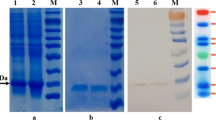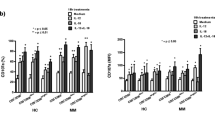Abstract
Glutathione (GSH), the most prevalent intracellular non-protein thiol, plays an important role in the interleukin-2 (IL-2)-induced proliferative activity of normal and tumour cells expressing IL-2 receptor (IL-2R). In the present study, we investigate the effect of IL-2 on proliferation of the human melanoma A375 cell line, and the possible selective cytomodulation effect of this cytokine by l-2-oxothiazolidine-4-carboxylate (OTZ) on these melanoma cells and on human peripheral blood mononuclear cells (PBMCs). We found that recombinant IL-2 (rIL-2) significantly increased the proliferation rate of A375 melanoma cells, which was associated with an increase in GSH levels, the enhancement of IL-2Rα expression and the endogenous production of IL-2 in these tumour cells. In contrast, OTZ decreased GSH content and the proliferation rate of A375 cells, and abrogated the growth-promoting effects of rIL-2. Thus, compared to cells treated with rIL-2, pre-treatment with OTZ reduced IL-2Rα expression, and also decreased the consumption of rIL-2 and the endogenous secretion of IL-2 by these tumour cells. With regard to PBMCs, the combination of OTZ plus rIL-2 resulted in a more rapid and greater increase of IL-2Rα expression than rIL-2 alone, with the proliferation rate being similar in the first 24 h, but with a lower PBMC′ count found thereafter compared to rIL-2 treatment alone. These results suggest that OTZ plays a crucial role in obtaining a selective cytomodulation of rIL-2, enabling it to exert its growth-promoting effect on normal cells, but not on melanoma cells, thereby possibly improving biochemotherapy with rIL-2.







Similar content being viewed by others
References
Aidoo A, Lyn-Cook LE, Morris SM, Kodell RL, Casciano DA (1991) Comparative study of intracellular glutathione content in rat lymphocyte cultures treated with 2-mercaptoethanol and interleukin-2. Cell Biol Toxicol 7:215
Atkins MB, Lee S, Flaherty LE, Sosman JA, Sondak VK, Kirkwood JM (2003) A prospective randomized phase III trial of concurrent biochemotherapy (BCT) with cisplatin, vinblastine, dacarbazine (CVD), IL-2 and interferon alpha-2b (IFN) versus CVD alone in patients with metastatic melanoma [E3695]: an ECOG-coordinated intergroup trial. Proc Am Soc Clin Oncol 22:708
Atkins MB, Lotze MT, Dutcher JP, Fisher RI, Weiss G, Margolin K, Abrams J, Sznol M, Parkinson D, Hawkins M, Paradise C, Kunkel L, Rosenberg SA (1999) High-dose recombinant interleukin-2 therapy for patients with metastatic melanoma: Analysis of 270 patients treated between 1985 and 1993. J Clin Oncol 17:2105
Barberá-Guillem E, Sampsel JW (2003) Immune-promoted tumor cell invasion and metastasis. In: Llombart-Bosch A, Felipo V (eds) New trends in cancer for the 21st century. Kluwer Academic, New York
Bendetto JP, Ortone JP, Voulot C, Khatchadourian C, Prota, Thivolet J (1981) Role of thiol compounds in mammalian melanin pigmentation: Part I. Reduced and oxidized glutathione. J Invest Dermatol 77:402
Bilbao P, del Olmo M, Alonso-Varona A, Castro B, Bilbao J, Palomares T (2002) l-2-oxothiazolidine-4-carboxylate reverses the tumour growth-promoting effect of interleukin-2 and improves the anti-tumour efficacy of biochemotherapy in mice bearing B16 melanoma liver metastases. Melanoma Res 12:17
Chen X, Batist G (1998) Sensitization effect of l-2-oxothiazolidine-4-carboxylate on tumor cells to melphalan and the role of 5-oxo-l-prolinase in glutathione modulation in tumor cells. Biochem Pharmacol 56:743
Chen X, Schecter RL, Griffith OW, Hayward MA, Alpert LC, Batist G (1998) Characterization of 5-oxo-l-prolinase in normal and tumor tissues of humans and rats: a potential new target for biochemical modulation of glutathione. Clin Cancer Res 4:131
De Gast GC, Batchelor D, Kersten MJ, Vyth-Dreese FA, Sein J, van de Kasteele WF, Nooijen WJ, Nieweg OE, de Waal MA, Boogerd W (2003) Temozolomide followed by combined immunotherapy with GM-CSF, low-dose IL-2 and IFNα in patients with metastatic melanoma. Br J Cancer 88:175
Del Olmo M, Alonso-Varona A, Castro B, Calle Y, Bilbao P, Palomares T (2000) Effects of l-2-oxothiazolidine-4-carboxylate on the cytotoxic activity and toxicity of cyclophosphamide in mice bearing B16F10 melanoma liver metastases. Melanoma Res 10:103
Dillman RO, Soori G, Wiemann MC, Schulof R, Dobbs TW, Ruben RH, DePriest CB, Church C (2000) Phase II trial of subcutaneous interleukin-2, subcutaneous interferon-α, intravenous combination chemotherapy, and oral tamoxifen in the treatment of metastatic melanoma: final results of cancer biotherapy research group 94–11. Cancer Biother Radiopharm 15:487
Fisher WH, Thor Straten P, Terheyden P, Becker JC (1999) Function and dysfunction of CD4+ T cells in the immune response to melanoma. Cancer Immunol Immunother 48:363
García de Galdeano A, Boyano MD, Smith-Zubiaga, Cañavate ML (1996) B16F10 murine melanoma cells express interleukin-2 and a functional interleukin-2 receptor. Tumor Biol 17:155
García-Vazquez MD, Boyano MD, Cañavate ML, Gardeazabal J, García de Galdeano A, López-Michelena T, Ratón JA, Izu R, Díaz-Ramón JL, Díaz-Pérez JL (2000) Interleukin-2 enhances the growth of human melanoma cells derived from primary but not from metastatic tumours. Eur Cytokine Netw 11:654
Gómez J, González A, Martínez C, Rebollo A (1998) IL-2 induced cellular events. Crit Rev Immunol 18:185
Hargrove ME, Wang J, Tiang CC (1993) Regulation by glutathione of the activation and differentiation of IL-4-dependent activated killer cells. Cell Immunol 149:433
Helmbach H, Rossmann E, Kern MA, Schadendorf D (2001) Drug-resistance in human melanoma. Int J Cancer 93:617
Hissin PJ, Hilf R (1976) A fluorometric method for determination of oxidized and reduced glutathione in tissues. Anal Biochem 74:214
Kedar E, Ben-aziz R, Epstein E, Leshem B (1989) Chemo-immunotherapy of murine tumors using interleukin-2 (IL-2) and cyclophosphamie. Cancer Immunol Immunother 29:74
Keilholz U, Punt CJ, Gore M, Suciu S, Kruit W, Patel P, Lienard J, Lehmann TF, Eggermont AM (2003) Dacarbazine, cisplatin and IFN-alpha-2b with and without IL-2 in advanced melanoma: Final analysis of EORTC randomized phase III trial 18951. Proc Am Soc Clin Oncol 22:708
Khayat D, Borel C, Tourani JM, Benahammouda A, Antoine E, Rixe O, Vuillemin E, Bazex PA, Thill L, Franks R, Auclerc G, Soubrane C, Banzet P, Weil M (1993) Sequential chemoimmunotherapy with cisplatin, interleukin-2, and interferon alfa-2a for metastatic melanoma. Clin Oncol 11:2173
Leaf CD, Pace GW (1994) Development of a novel glutathione repleting agent, l-2-oxothiazolidine-4-carboxylic acid (Procysteine). Exp Opin Invest Drugs 3:1293
Lee FYF, Siemann DW (1989) Isolation by flow cytometry of a human ovarian tumor cell subpopulation exhibiting a high glutathione content phenotype and increased resistance to adriamycin. Int J Radiat Oncol Biol Phys 16:1315
Liang ChM, Lee N, Cattell D, Liang SM (1989) Glutathione regulates interleukin-2 activity on cytotoxic T-cells. J Biol Chem 264:13519
Lindner P, Rizell M, Mattsson J, Hellstrand K, Naredi P (2004) Combined treatment with histamine dihydrochloride, interleukin 2 and interferon-alpha in patients with metastatic melanoma. Anticancer Res 24:1837
Lowry OH, Rosebrough NJ, Farr AL, Randall R (1951) Protein measurement with the Folin phenol reagent. J Biol Chem 193:265
Lu Y, Morley P, Durkin JP (1999) Signalling events mediating the activation of protein kinase C by interleukin-2 in cytotoxic T cells. Cell Signal 11:275
Malek TR, Bayer AL (2004) Tolerance, not immunity, crucially depends on IL-2. Nat Rev Immunol 4:665
Manola J, Atkins M, Ibrahim J, Kirkwood J (2000) Prognostic factors in metastatic melanoma: a pooled analysis of Eastern Cooperative Oncology Group trials. J Clin Oncol 18:3782
Margolin KA (2004) Biochemotherapy for melanoma. Rational therapeutics in the search for weapons of melanoma destruction. Cancer 101:435
McMillan DN, Kernohan NM, Flett ME, Heys SD, Deehan DJ, Sewell HF, walker F, Eremin O (1995) Interleukin 2 receptor expression and interleukin 2 localization in human solid tumour cells in situ and in vitro: evidence for a direct role in the regulation of tumour cell proliferation. Int J Cancer 60:766
Meister A, Anderson ME (1983) Glutathione. Annu Rev Biochem 52:711
Misawa E, Sakurai T, Yamada M, Hayasawa H, Motoyoshi K (2003) Booster effect of interleukin-2 on natural killer 1.1+ cells stimulated by administration of macrophage colony-stimulating factor in mice. J Immunol 26:21
Mortarini R, Piris A, Maurichi A, Molla A, Versan I, Bono A, Bartoli C, Santinami M, Lombardo C, Ravagnani F, Cascinelli N, Parmiani G, Anichini A (2003) Lack of terminally differentiated tumor-specific CD8(+) T cells at tumor site in spite of antitumor immunity to self-antigens in human metastatic melanoma. Cancer Res 63:2535
Multhoff G, Meier T, Botzler C, Wiesnet M, Allenbacher A, Wilmanns W, Issels R (1995) Differential effects of ifosfamide on the capacity of cytotoxic T lymphocytes and natural killer cells to lyse their target cells correlate with intracellular glutathione levels. Blood 85:2124
Palomares T, Alonso-Varona A, Alvarez A, Castro B, Calle Y, Bilbao P (1997) Interleukin-2 increases intracellular glutathione levels and reverses the growth-inhibiting effects of cyclophosphamide on B16 melanoma cells. Clin Exp Metastasis 15:329
Palomares T, Bilbao P, Alonso-Varona A, Barbera-Guillem E (1995) The addition of interleukin-2 to cyclophosphamide therapy can facilitate tumor growth of B16 melanoma. Cancer Immunol Immunother 40:292
Palomares T, Bilbao P, del Olmo M, Castro B, Calle Y, Alonso-Varona A (1999) In vitro and in vivo comparison between the effects of treatment with adenosine triphosphate and treatment with buthionine sulfoximine on chemosensitization and tumour growth of B16 melanoma. Melanoma Res 9:233
Pineda-Molina E, Klatt P, Vázquez J, Marina A, García de Lacoba M, Pérez-Sala D, Lamas S (2001) Glutathionylation of p50 subunit of NK-κB: a mechanism for redox-induced inhibition of DNA binding. Biochemistry 40:14134
Plaisance S, Rubenstein E, Alileche A, Sahraoui Y, Krief P, Augery-Bourget Y, Jasmin C, Suarez H, Azzarone B (1992) Expression of the interleukin-2 receptor on human fibroblast and its biological significance. Int Immunol 4:739
Rimoldi D, Salvi S, Hartmann F, Schreyer M, Blum S, Zografos L, Plaisance S, Azzarone B, Carrel S (1993) Expression of IL-2 in human melanoma cells. Anticancer Res 13:555
Rosenberg SA, Lotze MT, Yang JC, Aebersold PM, Linehan WM, Seipp CA, White DE (1989) Experience with the use of high-dose interleukin 2 in the treatment of 652 cancer patients. Ann Surg 210:474
Rosenberg SA, Yang JC, Schwartzentruber DJ, Hwu P, Marincola FM, Topalian SL, Seipp CA, Eihorn JH, White DE, Steinberg SM (1999) Prospective randomised trial of the treatment of patients with metastatic melanoma using chemotherapy with cisplatin, dacarbazine, and tamoxifen alone or in combination with interleukin-2 and interferon alfa-2b. J Clin Oncol 17:968
Rosenberg SA, Yang JC, Topalian SL, Schwartzentruber DJ, Weber JS, Parkinson DR, Seipp CA, Einhorn JH, White DE (1994) Treatment of 283 consecutive patients with metastatic melanoma and renal cell cancer using high-dose bolus interleukin-2. JAMA 271:907
Rosenberg SA, Yang JS, White DE, Steinberg SM (1998) Durability of complete responses in patients with metastatic cancer treated with high-dose interleukin-2: Identification of the antigens mediating response. Ann Surg 228:307
Schrades AJ (2000) Combined chemoimmunotherapy in metastatic melanoma. Is there a need for the double? Anti-Cancer Drugs 11:143
Slominski A, Paus R, Mihm MC (1998) Inhibition of melanogenesis as an adjuvant strategy in the treatment of melanotic melanomas: selective review and hypothesis. Anticancer Res 18:3709
Smith KA (1988) Interleukin-2: inception, impact, and implications. Science 240:1169
Suthanthiran M, Anderson ME, Sharma VK, Meister A (1990) Glutathione regulates activation-dependent DNA synthesis in highly purified normal human T lymphocytes stimulated via the CD2 and CD3 antigens. Proc Natl Acad Sci USA 87:3343
Waldmann TA (1989) The multi-subunit interleukin-2 receptor. Annu Rev Biochem 58:875
Ward ME, Pierce DS, Chung SE, Gravitt KR, O’Brian CA (1998) Irreversible inactivation of protein kinase C by glutathione. J Biol Chem 273:12558
Acknowledgements
We are grateful to A. Iglesias for assistance with flow cytometry. This work was supported by the University of the Basque Country (project 9/U.P.V. 00077.327-15830/2004), F.I.S (PI030452) and the Jesús Gangoiti Barrera Foundation.
Author information
Authors and Affiliations
Corresponding author
Rights and permissions
About this article
Cite this article
Olmo, M.d., Alonso-Varona, A., Castro, B. et al. Cytomodulation of interleukin-2 effect by l-2-oxothiazolidine-4-carboxylate on human malignant melanoma. Cancer Immunol Immunother 55, 948–957 (2006). https://doi.org/10.1007/s00262-005-0087-5
Received:
Accepted:
Published:
Issue Date:
DOI: https://doi.org/10.1007/s00262-005-0087-5




